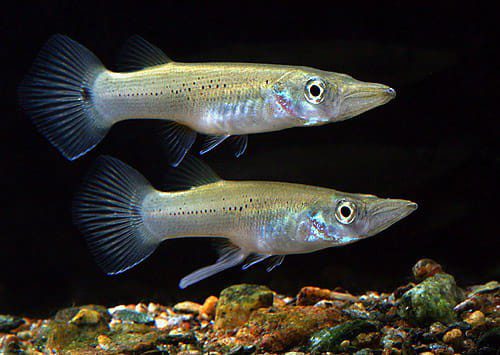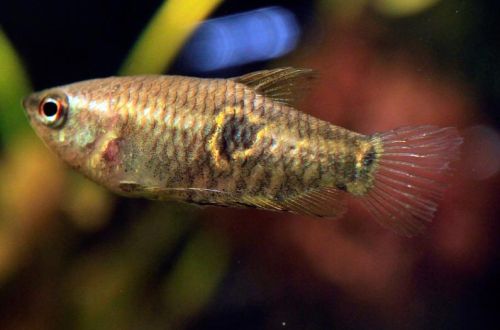
Belonesox
Belonesox, scientific name Belonesox belizanus, belongs to the Poeciliidae family. Despite its modest size, this is a formidable predator, hunting from ambush, even a fish similar in size to it can become its prey. With its outlines, behavior and method of hunting, it is similar to the Central European pike, only in miniature.

Habitat
Occurs in the warm marshy waters of Central America, common in the deltas of rivers flowing into the sea. The natural environment is rich in vegetation and numerous species of fish, in particular representatives of the same family Poeciliidae, which are the basis of its diet.
Requirements and conditions:
- The volume of the aquarium – from 200 liters.
- Temperature – 24-30°C
- Value pH — 7.0–8.5
- Water hardness – medium hard to hard (12-25 dGH)
- Substrate type – any
- Lighting – moderate
- Brackish water – desirable, concentration 1 teaspoon of salt (without a slide) per 10 liters
- Water movement – light or moderate
- Size – up to 18 cm.
- Food – live fish
Description

Belonesox has an elongated body with a spindle-shaped head and an elongated toothy mouth. The dorsal and anal fins are shifted closer to the large tail, which gives rapid acceleration during a sharp jerk. Its entire appearance resembles a river pike. Females are significantly larger than males. The coloration is gray-brown with several black spots forming a line along the entire body. The fins are transparent, on the tail closer to the base there is a large dark spot.
Food
They feed exclusively on live food. You can serve small fish that breed quickly, such as Formosa, Guppy, Gambusia and the like. It is allowed to include worms, large insect larvae in the diet. Feed at intervals of the day, if the fish are full, the prey can remain safe in the same aquarium until the next meal.
Maintenance and care
Often, normal settled tap water with a neutral or slightly alkaline pH value is suitable for filling an aquarium. Allowed to be in brackish water.
The high quality of water is maintained by weekly renewal of part of its volume by 10–20%, by cleaning the soil from organic waste, and by installing a productive filtration system. Other important equipment consists of a heater, aeration systems and lighting.
In the design, pay special attention to the vegetation cover, it should consist of strong root plants, securely fixed in the ground. Design areas with dense vegetation, prey will hide in them until it is eaten.
Social behavior
Aggressive predator, attacks any fish that is smaller than him. They form a stable pair – male / female, keeping alone is unacceptable.
Breeding / breeding
Optimal conditions for spawning are warm, slightly brackish water and sufficient food. The beginning of the breeding season can be identified by the female, her abdomen is swollen, as if she had just had lunch. The entire incubation period, fertilized eggs are in the body of the fish, and already formed fry are born. This feature has developed evolutionarily as an effective protection of offspring. Juveniles are recommended to be moved to a separate tank, fed with worms, insect larvae or fry of other fish.
Fish diseases
Diseases are not characteristic of predatory fish unless they are caused by injury or poor water conditions. They eat other fish, which are often weakened, sickly, etc., this is how natural selection works, so Belonesox has excellent immunity and does not adopt the diseases of its prey.





